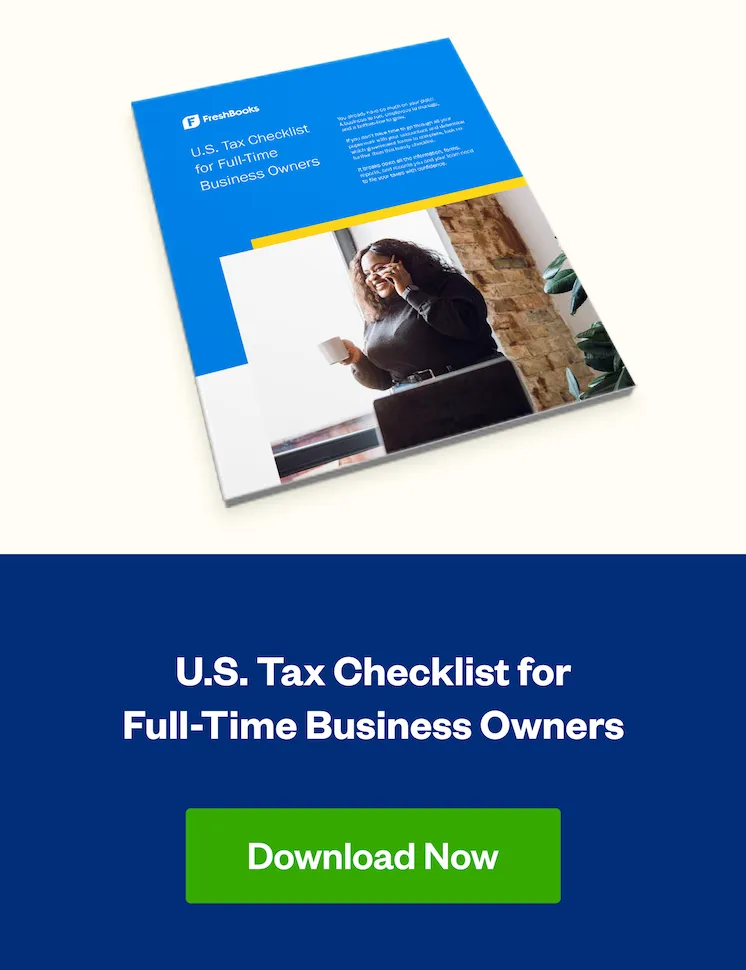It's tax time...again. Be sure that you're not leaving money on the table by forgetting about these 7 important tax deductions.

What’s the most confusing and stressful aspect of being a creative business owner? Ask a handful of creatives that question, and there’s a good chance dealing with taxes and knowing what itemized deductions can be used is at the top of that list.
At times, it seems that the U.S. tax system and filing a tax return are deliberately complex. There are so many forms, rules, and instructions written in legalese. Getting help from the IRS is nearly impossible, and sound advice can be costly.
Despite these headaches, it’s so important to keep track of tax deductions that can be used to offset your business’s taxable income and reduce the amount of income tax your small business owes.
Following are 6 of the most commonly missed tax deductions for creative businesses—and how not to miss them when you file your tax return.
Tax Deduction #1: Education and Conferences
The cost of educating yourself to improve your small business is a deductible business expense. When you take courses online, buy instructional books, attend conferences or workshops, hire a coach or join a mastermind group to improve skills in your field, be sure to keep proof that the expense was business-related. A copy of the course description or materials to prove that the expense was business-related should suffice.
Keep in mind that educational expenses to change careers or in areas not related to your current work are not tax-deductible business expenses and won’t lower your taxable income.
Tax Deduction #2: Subscriptions
Most creative small business owners use a combination of apps, software, and online tools to run their small business. However, these tax deductions are often overlooked because they might be small amounts, occurring monthly or annually, and paid for with a personal credit card.
Be sure you keep records of any expenses for cloud accounting software, productivity apps for your small business, cloud storage apps, social media management tools, and online shopping carts. And don’t forget about analog subscriptions for trade or professional publications. All are deductible as long as they are used for your business.
To make it easier to remember them, pay for all subscriptions and one-time app purchases with a business debit or credit card. Then all your deductible subscriptions will be in one place.
Tax Deduction #3: Internet and Cell Phone Expenses
Many creative business owners work from home and have only one cell phone they use for both business and personal purposes. In these cases, you can deduct a percentage of your home internet and cell phone expenses based on an estimate of how much you use them for business purposes.
The key to taking a tax deduction for your home internet and cell phone is to be reasonable and consistent. Unless you have a separate cell phone used only for small business purposes, you likely use the phone to call family members, play games and take photos and use your home internet to stream entertainment and other personal tasks. So don’t try to claim 100% of your monthly cost as a business expense.
To estimate your tax deduction, you might track the number of hours you work during the month. For example, say you work 40 hours a week. That’s roughly 160 hours a month out of 672 total hours (24 hrs x 7 days x 4 weeks) or 24 percent. If your home internet costs $100 per month, you will deduct $24 per month as a business expense. That’s not the only legitimate way to estimate costs, so do what works in your situation. Just make sure your tax deduction is reasonable, used consistently, and you keep copies of your itemized bills to support your tax deduction should you ever be audited.
Tax Deduction #4: Car and Truck Expenses
Many creative business owners forget to track business miles driven by their personal vehicles. If you work from a home office and rarely meet with clients in person, you might think you don’t drive enough for it to matter, but even a few miles a month for running business errands can add up to one of your most substantial tax deductions over the course of a year.
There are two methods to calculate automotive tax deductions: Standard mileage or actual cost. You can use whichever method results in the larger tax deduction. With the standard mileage method, you keep track of how many miles you drive for business, then multiply those miles by the standard mileage rate.
With the actual expense method, you keep track of how many miles you drive for business and how many miles you drive overall and use these numbers to calculate a percentage of business use. Then you apply that percentage to all your automobile expenses for the year, including gas and oil, repairs and maintenance, license and registration, insurance, car washing, etc.
Note that either method involves keeping track of how many miles you drove for business but logging those miles doesn’t have to be a chore. There are various apps to track miles, or you can even use an old-fashioned logbook. Whichever method you choose, make sure you keep a good set of mileage records on hand at tax time so your tax professional can help you decide which method is most advantageous for you.
Tax Deduction #5: Payment Processing Fees
It’s always a bummer to see those fees from PayPal, Square, or other payment processing systems take a bite out of your business income. Still, those fees are usually a necessary cost of doing business.
Typically, payment processing fees aren’t accounted for when you mark an invoice as paid in your accounting software. For instance, say you invoice a client for $500, and they pay you via PayPal. When you mark the invoice as paid, you’ll record income of $500. But behind the scenes, PayPal is deducting a fee of $14.80 (that’s 2.9% of the transaction amount plus 30 cents) from your account.
No matter how much or how little business you’ve transacted over the site in the course of a year, make sure you print out an account history at the end of the year and pick up these fees as a bank or payment processing fee expense. Then include them on your income taxes to reduce your taxable income.
Tax Deduction #6: Digital Downloads
Do you purchase fonts, stock photos, templates, workbooks, or other digital products for business use? Again, these are typically modest amounts on an individual transaction level that can really add up over the course of a year. But they’re easy to overlook when you purchase them only occasionally.
Be sure you purchase these items using your business debit or credit card to easily track these expenses throughout the year. You can lump them together and call the expense digital downloads or cost of goods sold when you deduct them on your return.
Tax Deduction #7: Home Office Expenses
If you have a home office for your small business, you can often deduct a portion of your housing expenses against business income. There are two ways to deduct home office expenses.
- Simplified method. You can deduct $5 per square foot of your home that you use for business, up to a maximum of 300 square feet.
- Standard method. Track all the actual expenses of maintaining your home (e.g., mortgage interest or rent, utilities, real estate taxes, housekeeping and landscaping service, homeowners association fees, and repairs). Then, multiply each of these expenses by the percentage of your home you devote to business use.
To qualify for a home office deduction, 2 specific areas need to be fulfilled:
- Regular and exclusive use. You must regularly use your home office exclusively for conducting business activities. This is a requirement. Using your kitchen table as your desk doesn’t work. You don’t need to dedicate an entire room to your business, but your work area should be clearly defined. Keep photos of your home office workspace with your tax documentation as evidence, just in case. You never know when an audit will come, and all documentation is helpful to prove the legitimacy of tax deductions.
- Principal place of business. Your home office must be your principal place of business. This means you spend the most time in the area you designate as your home office. It also means that you conduct important business activities here regularly, as indicated above.
If you use the standard method for calculating your home office deduction, you’ll need to file Form 8829 along with your Schedule C.
In Conclusion
Dealing with taxes may be a necessary cost of doing business, but paying too much in taxes doesn’t have to be. Make sure you’re aware of any unique tax deductions that can be used to defray your total tax bill and keep records of those expenses, no matter how small. All of them contribute to reducing local income taxes and your federal income tax.
Deductions can also change from tax year to tax year, so be sure to work with your accountant or keep yourself up to date on any significant changes.
This post was updated in November 2021.
Reviewed for accuracy by Janet Berry-Johnson, CPA.
about the author
Janet Berry-Johnson, CPA, is a freelance writer with over a decade of experience working on both the tax and audit sides of an accounting firm. She’s passionate about helping people make sense of complicated tax and accounting topics. Her work has appeared in Business Insider, Forbes, and The New York Times, and on LendingTree, Credit Karma, and Discover, among others. You can learn more about her work at jberryjohnson.com.

 A U.S. Freelancer’s Handy Guide to Quarterly Taxes
A U.S. Freelancer’s Handy Guide to Quarterly Taxes Still Waiting on Your U.S. Tax Refund? Here Are the Reasons for the Hold Up
Still Waiting on Your U.S. Tax Refund? Here Are the Reasons for the Hold Up Fight Your Tax Fears: Do These 5 Things to Pass a U.S. Tax Audit
Fight Your Tax Fears: Do These 5 Things to Pass a U.S. Tax Audit






